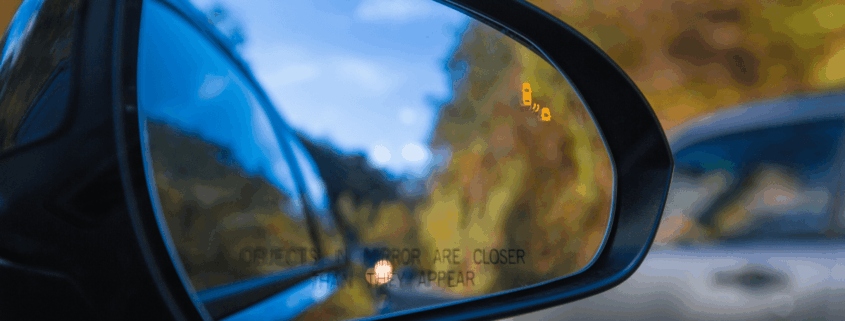Proving Driver Blind Spot Negligence in Chicago Side-Swipe Motorcycle Accidents
The open road offers a sense of freedom that few other experiences can match, but for a motorcyclist navigating the dense traffic of Chicago, that freedom comes with a constant need for awareness. A rider sees everything. Unfortunately, the drivers of cars, SUVs, and trucks often do not. The most common and terrifying phrase a rider hears after being sideswiped is, “I never even saw you.” That single statement highlights the immense danger of a driver’s blind spot.
What Are Vehicle Blind Spots or “No-Zones”?
Every vehicle has areas around it that cannot be seen directly by the driver using their mirrors alone. These areas are known as blind spots or “no-zones.” While drivers are trained to be aware of these zones and compensate by turning their heads, many fail to do so, putting motorcyclists at extreme risk. The size and location of these blind spots vary by vehicle.
Passenger Cars and SUVs: These vehicles have significant blind spots on both the left and right rear quarters. A motorcycle can easily disappear from view in these areas. The vehicle’s roof supports, known as A-pillars (on either side of the windshield) and B-pillars (between the front and back doors), can also momentarily hide an approaching motorcycle, especially at intersections.
Commercial Trucks and Semi-Trailers: The blind spots on a large truck are enormous. These no-zones are so extensive that a truck driver can lose sight of multiple cars, let alone a single motorcycle. The primary no-zones for a semi-truck include:
- Directly in Front: Extending up to 20 feet forward from the cab.
- Directly Behind: Stretching approximately 30 feet from the rear of the trailer.
- The Left Side: Alongside the driver’s door, where visibility is limited.
- The Right Side: This is the largest and most dangerous blind spot, spanning multiple lanes of traffic and running the entire length of the truck and trailer.
A driver’s failure to account for these blind spots before changing lanes or turning is a frequent cause of sideswipe collisions on busy Chicago roads.
Why Are Motorcyclists So Vulnerable to Blind Spot Accidents?
Motorcycles are uniquely susceptible to being overlooked by other drivers for several reasons. Their narrow profile makes them harder to spot in a quick glance at a side-view mirror. A car driver might be looking for other cars, and their brain may not register the smaller, less familiar shape of a motorcycle.
Furthermore, a motorcycle’s position within a lane can affect its visibility. If a rider is in the far left or right portion of a lane, they are more likely to fall into the blind spot of a vehicle in the adjacent lane. The speed and acceleration of motorcycles can also play a role. A bike can approach a car’s blind spot much faster than another car might, surprising a driver who checked their mirror only moments before initiating a lane change.
Common Scenarios for Sideswipe Accidents in Chicago
The high-density traffic on Chicago’s expressways and multi-lane city streets creates countless opportunities for blind spot accidents. These incidents are not random; they often happen in predictable situations where a driver’s negligence is the root cause.
- Improper Lane Changes on Expressways: A driver on the Kennedy or Dan Ryan Expressway decides to move into an adjacent lane to pass a slower vehicle. They glance in their mirror but fail to turn their head, completely missing the motorcyclist riding alongside them.
- Merging onto Highways: When a car merges onto Lake Shore Drive from an on-ramp, the driver may be focused on finding a gap in traffic ahead of them, neglecting to check the large blind spot over their right shoulder where a motorcyclist is already present.
- Making Turns on City Streets: A driver on a multi-lane street like Michigan Avenue or Western Avenue intends to make a right turn. They fail to see a motorcyclist in the rightmost lane or bike lane, turning directly into the rider’s path.
- Distracted Driving: A driver texting, adjusting their GPS, or reaching for something inside their car is not paying full attention to the road. This divided attention makes it far less likely they will perform the necessary head check to clear their blind spots before maneuvering.
How Is Driver Negligence Proven in a Motorcycle Blind Spot Claim?
To secure compensation after a sideswipe accident, you and your attorney must prove that the other driver was negligent. Negligence is a legal term that means a person failed to exercise a reasonable level of care, and that failure caused harm to someone else. In Illinois, proving negligence requires establishing four specific elements.
- Duty of Care: Every driver on the road has a legal duty to operate their vehicle safely to avoid harming others. This includes maintaining awareness of their surroundings, checking blind spots, using turn signals, and obeying all traffic laws.
- Breach of Duty: The driver failed to meet their duty of care. In a blind spot case, this breach could be making a lane change without looking, turning without signaling, driving while distracted, or otherwise failing to confirm the path was clear.
- Causation: The driver’s breach of duty was the direct and proximate cause of the accident and your injuries. It must be shown that the collision would not have occurred if the driver had acted with reasonable care (e.g., if they had properly checked their blind spot).
- Damages: You suffered actual harm as a result of the accident. This includes physical injuries, medical bills, damage to your motorcycle, lost wages, and pain and suffering.
Successfully demonstrating these four points is the foundation of a strong personal injury claim.
What Evidence Is Essential for Building Your Case?
A strong claim is built on strong evidence. Insurance companies will often try to shift blame to the motorcyclist, using unfair stereotypes about riders being reckless. A skilled attorney will work to gather and preserve key evidence to counter these tactics and prove the driver’s fault.
- The Official Police Report: This report provides the responding officer’s initial findings, diagrams of the scene, and any citations issued to the driver.
- Eyewitness Testimony: Statements from other drivers, pedestrians, or passengers who saw the accident can provide an objective account of the driver’s actions.
- Photos and Videos: Pictures of the final resting positions of the vehicles, the damage to your bike and the other car, and any visible injuries are very important.
- Scene and Vehicle Analysis: The location of the impact on both your motorcycle and the other vehicle can tell a story. For example, damage to the side of your bike and the front quarter panel of the car strongly suggests a sideswipe from an improper lane change.
- Traffic and Dashcam Footage: Many intersections and businesses in Chicago have surveillance cameras. If available, this footage can provide indisputable proof of how the accident happened. Dashcam video from your own helmet or from other vehicles is also invaluable.
- Cell Phone Records: If distracted driving is suspected, your attorney can subpoena the driver’s cell phone records to show if they were texting, talking, or using data at the time of the collision.
- Accident Reconstruction: In complex cases, specialists can use physical evidence and engineering principles to create a scientific model of the crash, demonstrating how the driver’s failure to see you led to the impact.
Overcoming Unfair Insurance Company Defenses
Insurance adjusters are specifically trained to minimize the financial payout on claims. Their primary goal is to protect the insurance company’s bottom line, which often involves attempting to shift blame for the accident onto you, the motorcycle rider, in order to reduce the value of your claim. They employ various tactics and common defenses to achieve this, such as:
- “The motorcycle was speeding.” This is a frequently used tactic. Adjusters will argue that you were traveling at an excessive speed, making it impossible for the driver of the other vehicle to have seen you in time to avoid the collision. They may suggest that your speed contributed to the accident, thereby reducing their client’s liability.
- “The rider was lane splitting.” Lane splitting, which is defined as riding a motorcycle between lanes of slow or stopped traffic, is illegal in Illinois. While genuine lane splitting is indeed against the law, adjusters may attempt to manipulate the narrative. They might mischaracterize legal filtering (moving through traffic when it’s safe to do so) or simply being in a certain part of the lane as illegal lane splitting, even if your actions were entirely within the bounds of the law. This can be a deceptive tactic to assign partial fault to the rider.
- “The rider appeared out of nowhere.” This defense is a euphemism for the driver admitting they “weren’t looking properly” or “weren’t paying attention.” It implies that the motorcycle suddenly materialized without warning, making it seem as though the driver had no opportunity to react. However, a skilled motorcycle accident attorney can effectively challenge this argument by demonstrating that a reasonably careful and attentive driver would have observed your motorcycle and taken appropriate action.
An experienced motorcycle accident attorney understands these common defense strategies used by insurance adjusters. They are adept at anticipating these arguments and possess the legal knowledge and investigative skills to systematically dismantle them with credible evidence, ultimately strengthening your claim for fair compensation.
What Types of Compensation Can Be Recovered?
Victims of negligent drivers are entitled to seek compensation for the full extent of their losses. These damages are typically separated into two categories.
Economic Damages: These are the calculable financial losses you have incurred.
- All past and future medical bills (emergency services, surgery, physical therapy, medications)
- Lost wages from time missed at work
- Loss of future earning capacity if you are unable to return to your previous job
- The cost to repair or replace your motorcycle and damaged gear
Non-Economic Damages: These damages compensate for the intangible, personal losses that have a profound impact on your life.
- Pain and suffering
- Emotional distress and mental anguish
- Disfigurement and scarring
- Loss of a normal life or loss of enjoyment of activities
- Permanent disability
What Steps Should You Take Immediately After a Sideswipe Accident?
The actions you take in the minutes and hours after a crash are important for protecting your health and your legal rights.
- Get to Safety: If you can, move yourself and your bike out of the flow of traffic to prevent further injury.
- Call 911: Report the accident and request an ambulance. It is vital to get a medical evaluation, even if you think you are okay. Adrenaline can mask serious injuries.
- Document the Scene: If you are physically able, take pictures with your phone. Capture the license plate of the other vehicle, the damage, the road conditions, and any relevant traffic signs.
- Get Witness Information: If anyone stopped to help, get their name and phone number. Their account could be very helpful later.
- Do Not Admit Fault: Avoid making statements like “I’m sorry” or “I’m okay.” Stick to the facts when speaking with the police.
- Seek Medical Attention: Go to the hospital or an urgent care clinic to be checked out. This creates a medical record linking your injuries to the accident.
- Contact a Motorcycle Accident Attorney: Do not give a recorded statement to the other driver’s insurance company before speaking with a lawyer. They can use your words against you. An attorney will protect your rights and handle all communications on your behalf.
Contact a Chicago Motorcycle Accident Attorney Today
Being sideswiped by a driver who failed to see you is a traumatic experience. The physical pain, mounting medical bills, and time away from work can create immense stress for you and your family. You should not have to carry this burden alone. Holding the negligent driver accountable is the first step toward reclaiming your life. If you or a loved one has been injured in a blind spot motorcycle accident in Chicago or anywhere in Cook County, prompt action is essential.
Contact the Fotopoulos Law Office today at 708-942-8400 for a free consultation. We can evaluate your case, explain your legal options, and provide the dedicated representation you need to pursue the full and fair compensation you are owed.











Leave a Reply
Want to join the discussion?Feel free to contribute!